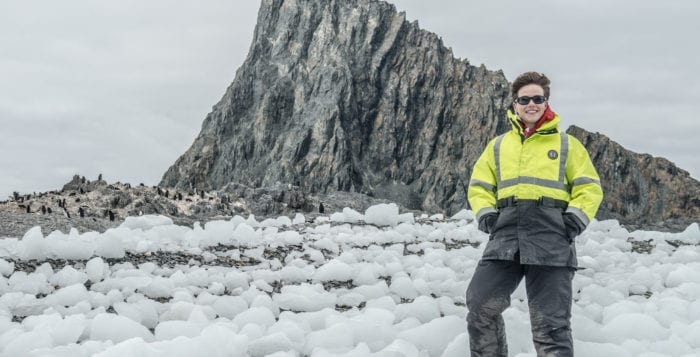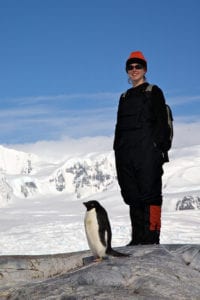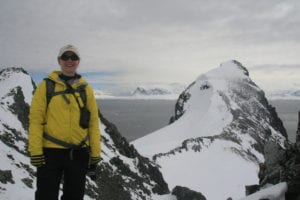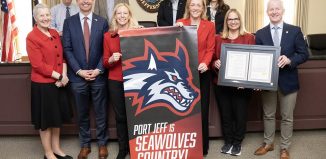SBU’s Heather Lynch performs pioneering penguin research

By Daniel Dunaief
Heather Lynch is thrilled that she’s in the first class of scientists chosen as a recipient of the National Geographic AI for Earth Innovation Grant.
An associate professor of ecology and evolution at Stony Brook University, Lynch uses computers to study satellite images to reveal details about populations of penguins.
In addition to determining how many penguins are in an area, Lynch also can use images of the stains penguin poop leaves on rocks to determine what the penguins eat. Krill, which feeds on the underside of ice, is reddish or pinkish, while fish leave a white stain.

A total of 11 researchers won the grants, which are a combined award from Microsoft and the National Geographic Society and were announced in December. The winners were chosen from more than 200 qualified scientists.
“This is the first grant that National Geographic and Microsoft are doing,” Lynch said. “It’s super exciting to be in the inaugural group.”
To hear from Lynch’s colleagues, she is an extraordinary candidate for a host of awards, including recognition as one of the TBR News Media People of the Year for 2018.
In addition to landing a coveted grant for her innovative research using sophisticated computers and satellite images, Lynch earlier this year made a remarkable discovery using Landsat imagery about a population of Adélie penguins on the Danger Islands in the Antarctic that was largely unknown prior to her published paper.
This archipelago of nine islands, which were named because of the ice that is impenetrable in most years, was home to 1.5 million penguins, which she surveyed using a combination of photos, drone imagery and hand counting. That figure represents a substantial population of a charismatic animal whose numbers often are used as a way to determine the health of a delicate region managed by a collection of nations.
“She does such good work,” said Patricia Wright, a distinguished service professor at Stony Brook University and the founder and executive director of Centre ValBio, a research station in Madagascar. Her discovery of the additional Adélie penguins was “fantastic.”
Lynch received some pushback from people who thought the discovery of these penguins ran counter to the narrative about the need for conservation. Wright appreciates how Lynch shared the discovery with the public, reinforcing her scientific credibility.
“She’s an example of a scientist who doesn’t give in to political pressure,” Wright said. “It’s difficult sometimes to face up to people who have good intentions, but who don’t seem to want to accept the reality.”
While the discovery of the Adélie penguins was remarkable, it doesn’t necessarily run contrary to the notion about the delicate balance of the Antarctic ecosystem, and it also doesn’t indicate that the population is soaring in a way the flightless water fowl never will. Indeed, the 1.5 million penguins may have been higher in the 1990s, although she is working to pin down exactly how much larger they might have once been.

Lynch has also won admiration and appreciation from Assemblyman Steve Englebright (D-Setauket), who recently won his 14th term and has focused attention on environmental issues.
“Her ability to use statistics and mathematics to further conservation biology is pioneering work and worthy of recognition,” Englebright said.
The assemblyman believes scientists and policymakers are still in the early part of the process of understanding the complexity of the ecosystems in the Antarctic.
Finding the penguins on the Danger Islands doesn’t mean the “Antarctic is any less at risk. We still have to place that discovery into its proper context and [Lynch] is helping us do that,” Englebright said.
People who have ventured to the Antarctic with her admire Lynch’s focus, energy
and stamina.
Michelle LaRue, who is a lecturer at the University of Canterbury in New Zealand, suggested that Lynch was “the most hardworking scientist that I know.”
LaRue recalled a time when Lynch was ill, and she still got up and did her job every day.
“The work we were doing wasn’t easy,” LaRue said. “I know she didn’t feel well and she kept going. She has a lot of perseverance.”
LaRue appreciates how her fellow scientist sees the “forest for the trees,” using a combination of high technology and considerable on-site counting to understand what changes in the penguin population reveal about the region.
Michael Polito, an assistant professor in the Department of Oceanography and Coastal Sciences at Louisiana State University, has also worked with Lynch for years. He appreciates how she’s “not afraid of uncertainty. In science, it’s knowing how well you know something. She’s amazing at taking data and information, which from the natural world is messy, and analyzing it and helping people pull useful and meaningful knowledge from complex situations.”
Ron Naveen, who founded the nonprofit group Oceanites in 1987, has worked with Lynch for 11 years.
“I’m very much proud of her work ethic and the standard of excellence she brings to the job,” Naveen said.
Oceanites collaborates with Lynch and others, Naveen said, to understand how penguins have reacted to climate change in an area where temperatures have been increasing at a faster rate than they have for much of the rest of the world.
Naveen recalls how Lynch, whom he describes as “petite and energetic” lugged around “amazingly heavy equipment,” including a camera for a Google Earth project.
“Whether [Lynch] is hiking, using a satellite or a drone, or lugging equipment that’s heavier than she is, she gets the data,” Naveen said.
He recalled a lab meeting with Lynch, who was a postdoctoral researcher at the University of Maryland in the lab of William Fagan. Lynch circled the room as she wrote on the board, sharing statistical language to explain a point.
“I had no bloody idea what she was talking about,” Naveen said. “When she was done, she sat down with a smile, and I raised my hand and innocently asked, ‘Would you mind translating that into plain English?’ Without missing a beat, she did.”
By all accounts, she’s continuing to do that.






